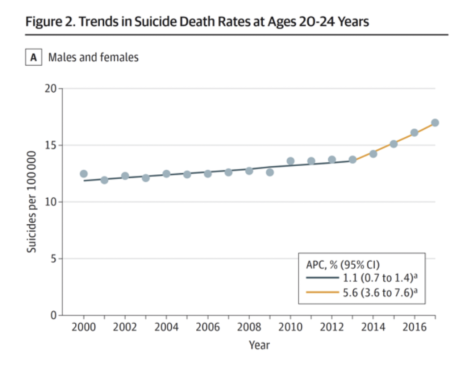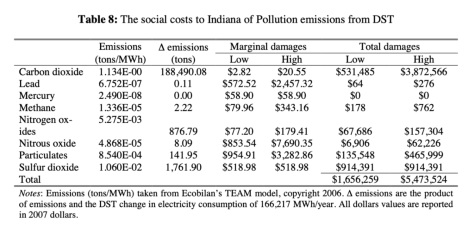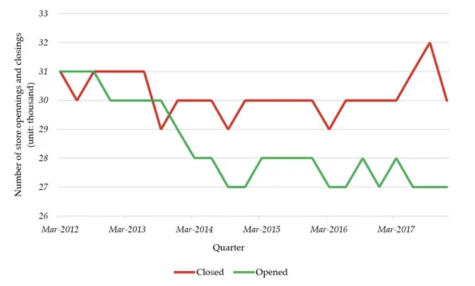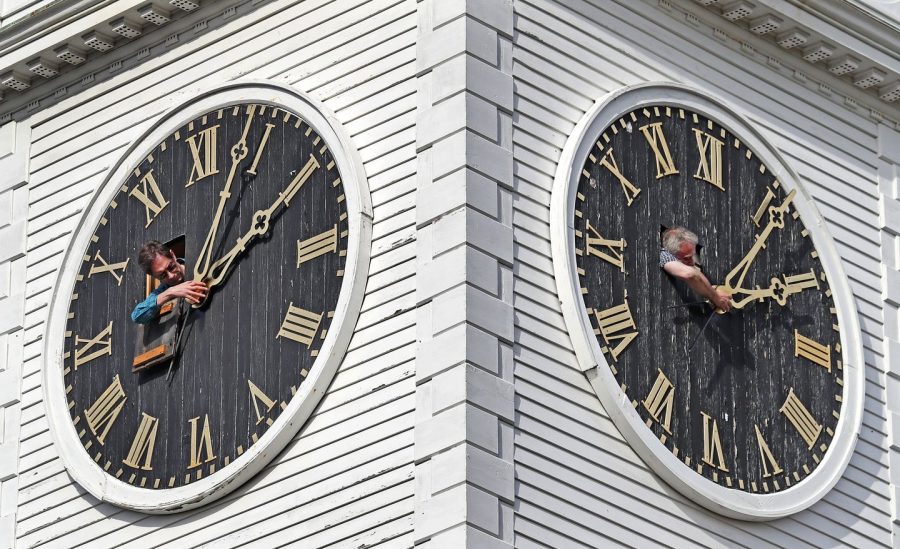Lock the Clock
An examination of the effectiveness of the Sunshine Protection Act in impacting public health, safety, and economic change in the United States.
Note: This article is an extremely abbreviated summary of a 22-page APA research paper. I’ve written a detailed, APA style research paper on the effects of the Sunshine Protection Act on public health, economic change, and public safety in the United States. I believe that this time policy change (Sunshine Protection Act) has way more broad and potent effects than you would think. Because it is a long paper, at least read the Research Findings & Analysis section for the main points. This would not have been possible without help from my mentor, Alice Ferguson, an undergraduate student from Harvard University
Read the full APA research paper here.
Twice a year, Americans “spring forward” and “fall back,” changing their clocks one hour ahead in the spring, and one hour back in the fall. This switch is between daylight saving time and standard time. Despite being considered “harmless,” shifting the clock is an obsolete practice that needs to be changed. Time changes are associated with a rise in suicide, car accidents, and an increased risk of diseases, like diabates, cancer, obesity and more (Fritz et al, 2020; Roenneberg & Merrow, 2016). Recognizing these detrimental effects, the Sunshine Protection Act has been proposed in the United States. It will eliminate this unnecessary practice. But, it has one fatal flaw: it will put the US on a permanent daylight saving time policy, exactly what sleep experts argue will cause mass dysregulation of our natural circadian rhythms, along with many other negative effects of this inferior time policy (Rishi et al., 2020). This time policy change would create many problems, like kids walking to school in the dark, decreased economic growth, permanent dysregulation of circadian rhythms, accelerated climate change effects, lower SAT scores, increased energy use, and more. This topic is imperative to discuss and debate as it relates to the rising global health problems we have today.
In the United States, we currently observe a time change policy where we change our clocks by one hour twice a year. This means the United States switches between daylight saving time and standard time twice a year. Standard time is considered the “normal” or “natural” time standard, while daylight saving time is an artificial time standard not aligned with our circadian rhythm that was introduced by Benjamin Franklin in 1784. The Sunshine Protection Act has proposed to implement permanent daylight saving time. We already implemented permanent daylight saving time in the 1970s, but it was so unpopular and unsafe that it was reversed in about a year’s time. Clearly, we haven’t learned a lesson, and as a result, permanent daylight saving time will have even more broad-ranging repercussions in today’s world, like accelerated climate change.
We are already experiencing a rise in global health issues. More than 87% of high school students do not get enough sleep which contributes to depression, anxiety, and stress, along with long-term health effects, like diabetes, cancer, and shortened life expectancy (Richter, 2015). Also, there is a concept named “bedtime procrastination,” where many students simply spend most of their day working or at school and do not have enough personal, relaxing time, so they often make this up by staying up later than they should, leading to the sleep deprivation problems stated above. “Bedtime procrastination” is often attributed to academic demand (Kroese et al., 2014). According to Frazee (2019), suicide rates in both young adults and adults are at an all-time high, further emphasizing the importance of discussing health when it comes to legislative moves.


In Russia and Turkey, permanent daylight saving time was implemented. It was found that more than two-thirds of Russians disliked permanent daylight saving time after the switch was made (BBC, 2014). Russia switched back to permanent standard time from permanent daylight saving time four years later in 2014 citing safety issues, such as a rise in car accidents and increased stress and health issues (BBC, 2014). Also, Roenneberg et al. (2019b) state that in Russia, a permanent “social jet lag” was discovered while permanent daylight saving time was implemented (para. 19). Additionally, in Turkey, it was found that economic growth was negatively impacted after permanent daylight saving time was implemented (Akarsu & Gumusoglu, 2019).
Evidence from sleep experts provide a strong preference to permanent standard time over permanent daylight saving time. This is largely due to daylight saving time’s misalignment with natural circadian rhythms, showing an expert opinion on why the Sunshine Protection Act should be modified. With standard time, sunlight is at its peak during noon, signaling to our circadian rhythm that it is the middle of the day. With daylight saving time, peak sunlight is one hour off, which in turn sets our circadian rhythm alignment with the natural world off by one hour. While this may not sound like a serious issue in terms of the effect it has on daily life, it can have major long-term effects. According to Roenneberg et al. (2019a), daylight saving time negatively affects our circadian rhythms and health compared to standard time. Sleep experts strongly support standard time rather than daylight saving time. Babilon et al. (2021) describe it as “permanent jet lag” (p. 1), describing how permanent daylight saving time will cause a permanent misalignment between our natural circadian rhythm and the time. The Sunshine Protection Act has clearly not taken the severe misalignment of daylight saving time and our circadian rhythms into account as daylight saving time could cause a rise in many health problems in the long-term.
Disrupted or misaligned circadian rhythms, a result of choosing the wrong time policy for human health, can lead to many detrimental negative health effects. Berk et al. (2008) state that even small disruptions or a minor misalignment in circadian rhythms can result in increased suicide rates. Furthermore, disruptions and misalignments of the circadian rhythm can lead to diseases like diabetes, cancer, and obesity (Fritz et al., 2020; Roenneberg & Merrow, 2016). The Sunshine Protection Act’s support of permanent daylight saving time will not be aligned with our circadian rhythms, potentially leading to a rise of the aforementioned diseases in the United States (Rishi et al., 2020).
The main reason why daylight saving time exists, energy savings, is an obsolete argument as daylight saving time no longer saves energy like it used to. It is estimated that daylight saving time only saves a small percentage of electricity annually (0.5%) based on a study conducted in Slovakia (Kudela et al., 2020). Studies from the past ten to fifteen years have shown that daylight saving time no longer serves its main purpose of saving energy. They show that daylight saving time either saves an extremely small amount of electricity or causes increased electricity use compared to standard time. In a study conducted in Indiana, electricity usage rose during daylight saving time. Electricity bills rose by $9 million in one year along with $1.7-5.5 million associated with the effects of increased environmental pollution as a result of increased electricity use (Kotchen & Grant, 2011). Kotchen & Grant (2011) also state that “the effect is likely to be even stronger in other regions of the United States” (p. 2).

Gasoline usage by vehicular transportation is affected by daylight saving time as well. Because of more sunlight in the evening with daylight saving time, people tend to go out more, leading to an increased use in gasoline usage. According to Segal (2020), “this could mean an additional 8,000 barrels of gasoline used per day based on US consumption, which further offsets electricity savings” (para. 5). Of course, gasoline and diesel usage have many negative effects on life expectancy, health, climate change, and air quality. It is estimated that premature deaths caused by gasoline and diesel are about 115,000 to 122,100 (on a 20-year scale), which could lead to around 2.10 to 2.21 million years lost of human life expectancy (Huang et al., 2020).
Of course, this increase in gasoline usage will strengthen and accelerate climate change as well. According to Fawzy et al. (2020), there were 315 natural disasters in 2018 that were related to climate change. Fawzy et al. (2020) also state that in 2018, economic losses caused by climate change added up to $131.7 billion. “Food, water, health, ecosystem, human habitat and infrastructure” (para. 1), critical aspects of life, are very vulnerable to the effects of climate change as well (Fawzy et al., 2020).
As mentioned in the case studies sub-section above, Turkey experienced negative economic growth and reduced economic productivity with the implementation of permanent daylight saving time (Akarsu & Gumusoglu, 2019). In the United States, while it is true that in-person consumer shopping increases slightly with permanent daylight saving time, the rise of online shopping and the decline of physical stores signals a change in consumer behavior that will lead to permanent daylight saving time not having the economic effect it currently has on consumer spending (Rao, 2019). Figure 4 shows the decline of physical stores.

Not only is consumer spending on in-person shopping declining, the increase that permanent daylight saving time brings to consumer spending is already very minimal. There is a slight rise in consumer spending on goods with daylight saving time, but the results can widely vary by various factors, like location (Farell et al., 2016).
Along with these negative societal effects of daylight saving time, detrimental effects will occur in the educational system as well. Choi et al. (2019) state that natural sunlight exposure for students in the morning positively affects their mental health and academic performance. Additionally, Lambert et al. (2002) state that sunlight contributes to increased serotonin levels, a chemical in the brain that regulates mood stability. Low serotonin levels are associated with many mood and mental disorders such as attention deficit-hyperactivity disorder (ADHD), increased impulsive aggression, and general sadness, all of which could affect students with low sunlight exposure in the morning followed by a majority of school time being spent indoors (Lambert et al., 2002; Wang et al., 2018). A lack of sunlight exposure in the morning could also potentially create dangerous situations for kids traveling to school in the dark, similar to what happened in the United States during the 1970s (Susanin & Polansky, 2022). Furthermore, the effect daylight saving time has on academic performance has been assessed with scores from Scholastic Aptitude Test (SAT). SAT scores were taken from schools in daylight saving time and were compared to schools in standard time. It was shown that schools in daylight saving time zones had an average decline in SAT scores of about sixteen points, a major, significant decline when the public’s reaction to slight annual changes in SAT score is taken into account (Gaski & Sagarin, 2011). Gathering all of the evidence together, it is clear that the contributors of the Sunshine Protection Act did not have the impetus to heavily research the destructive effects daylight saving time has on the educational system.
With permanent daylight saving time, the sun will not rise until 9:30 AM in some western states. In many parts of the US, this early morning darkness could mean children walking to school in the dark, posing many safety issues. This safety issue was one of the reasons cited during the removal of permanent daylight saving time in the United States in the 1970s.
Overall, it has been made clear over and over again that permanent daylight saving time is not what should be implemented in the United States based on the long-term destruction it will have on public health along with other negative effects, like on the educational system and climate change. It is absolutely imperative that US lawmakers reconsider the Sunshine Protection Act and conduct more thorough research and debate on the topic. Lawmakers should absolutely consider changing the Sunshine Protection Act to implement permanent standard time rather than permanent daylight saving time. It is great and necessary that lawmakers are working towards eliminating biannual time changes, but adequate public health support will not be achieved until lawmakers do thorough research on what can be done to ensure that Americans’ health are, at the very least, accounted for in the making of new laws and policies.
References
Adeyemi, O. J., Arif, A. A., & Paul, R. (2021). Exploring the relationship of rush hour period and fatal and non-fatal crash injuries in the US: a systematic review and meta-analysis. Accident Analysis & Prevention, 163, 106462. https://doi.org/10.1016/j.aap.2021.106462
Akarsu, G., & Gumusoglu, N. K. (2019). Economic Consequences of Daylight-Saving Time: Evidence from Turkey. Gümüşhane Üniversitesi Sosyal Bilimler Enstitüsü Elektronik Dergisi, 10(1), 18-31. https://dergipark.org.tr/en/download/article-file/679395
Babilon, S., Beck, S., & Khanh, T. Q. (2021). A field test of a simplified method of estimating circadian stimulus. Lighting Research & Technology, 14771535211044664. https://www.researchgate.net/profile/Sebastian-Babilon/publication/355809619_A_field_test_of_a_simplified_method_of_estimating_circadian_stimulus/links/617fd6b5a767a03c14dc0395/A-field-test-of-a-simplified-method-of-estimating-circadian-stimulus.pdf
BBC. (2014, July 22). Russia: Putin abolishes ‘daylight savings’ time change. BBC. Retrieved July 21, 2022, from https://www.bbc.com/news/blogs-news-from-elsewhere-28423647
Berk, M., Dodd, S., Hallam, K., Berk, L., Gleeson, J., & Henry, M. (2008). Small shifts in diurnal rhythms are associated with an increase in suicide: The effect of daylight saving. Sleep and Biological Rhythms, 6(1), 22-25. https://doi.org/10.1111/j.1479-8425.2007.00331.x
Carter, J. R., Knutson, K. L., & Mokhlesi, B. (2022). Taking to’heart’the proposed legislation for permanent daylight saving time. American Journal of Physiology-Heart and Circulatory Physiology. https://doi.org/10.1152/ajpheart.00218.2022
Chattu, V. K., Manzar, M. D., Kumary, S., Burman, D., Spence, D. W., & Pandi-Perumal, S. R. (2018, December). The global problem of insufficient sleep and its serious public health implications. Healthcare (Vol. 7, No. 1, p. 1). MDPI. https://www.mdpi.com/2227-9032/7/1/1
Choi, K., Shin, C., Kim, T., Chung, H. J., & Suk, H. J. (2019). Awakening effects of blue-enriched morning light exposure on university students’ physiological and subjective responses. Scientific reports, 9(1), 1-8. https://doi.org/10.1038/s41598-018-36791-5
DeAngelis, T. (2021, April 1). Mental illness and violence: Debunking myths, addressing realities. American Psychological Association. Retrieved August 13, 2022, from https://www.apa.org/monitor/2021/04/ce-mental-illness
Doleac, J. L., & Sanders, N. J. (2015). Under the cover of darkness: How ambient light influences criminal activity. Review of Economics and Statistics, 97(5), 1093-1103. https://doi.org/10.1162/REST_a_00547
Farrell, D., Narasiman, V., & Ward, M. (2016). Shedding Light on Daylight Saving Time. Available at SSRN 2966170. https://dx.doi.org/10.2139/ssrn.2966170
Fawzy, S., Osman, A. I., Doran, J., & Rooney, D. W. (2020). Strategies for mitigation of climate change: a review. Environmental Chemistry Letters, 18(6), 2069-2094. https://doi.org/10.1007/s10311-020-01059-w
Frazee, G. (2019, June 18). Suicide among teens and young adults reaches highest level since 2000. PBS. Retrieved August 13, 2022, from https://www.pbs.org/newshour/nation/suicide-among-teens-and-young-adults-reaches-highest-level-since-2000
Fritz, J., VoPham, T., Wright Jr, K. P., & Vetter, C. (2020). A chronobiological evaluation of the acute effects of daylight saving time on traffic accident risk. Current biology, 30(4), 729-735. https://www.sciencedirect.com/science/article/pii/S0960982219316781
Gaski, J. F., & Sagarin, J. (2011). Detrimental effects of daylight-saving time on SAT scores. Journal of Neuroscience, Psychology, and Economics, 4(1), 44. https://doi.org/10.1037/a0020118
Groen, J. A., & Pabilonia, S. W. (2019). Snooze or lose: High school start times and academic achievement. Economics of Education Review, 72, 204-218. https://doi.org/10.1016/j.econedurev.2019.05.011
Haikonen, H., & Summala, H. (2001). Effects of darkness on traffic accidents. PUBLICATIONS OF THE MINISTRY OF TRANSPORT AND COMMUNICATIONS, (40). https://trid.trb.org/view/772087
Huang, Y., Unger, N., Harper, K., & Heyes, C. (2020). Global climate and human health effects of the gasoline and diesel vehicle fleets. GeoHealth, 4(3), e2019GH000240. https://doi.org/10.1029/2019GH000240
Jenkins, E. (1974, January 31). SCHOOLS ASK END TO DAYLIGHT TIME. The New York Times. https://www.nytimes.com/1974/01/31/archives/schools-ask-end-to-daylight-time-pressure-follows-success-in-easing.html
Kotchen, M. J., & Grant, L. E. (2011). Does daylight saving time save energy? Evidence from a natural experiment in Indiana. Review of Economics and Statistics, 93(4), 1172-1185. https://doi.org/10.3386/w14429
Kroese, F. M., De Ridder, D. T., Evers, C., & Adriaanse, M. A. (2014). Bedtime procrastination: introducing a new area of procrastination. Frontiers in Psychology, 611. https://doi.org/10.3389/fpsyg.2014.00611
Kudela, P., Havranek, T., Herman, D., & Irsova, Z. (2020). Does daylight saving time save electricity? Evidence from Slovakia. Energy Policy, 137, 111146. https://doi.org/10.1016/j.enpol.2019.111146
Lambert, G. W., Reid, C., Kaye, D. M., Jennings, G. L., & Esler, M. D. (2002). Effect of sunlight and season on serotonin turnover in the brain. The Lancet, 360(9348), 1840-1842. https://doi.org/10.1016/S0140-6736(02)11737-5
Lochner, L. (2020). Education and crime. The economics of education (pp. 109-117). Academic Press. https://doi.org/10.1016/B978-0-12-815391-8.00009-4
Malow, B. A., Veatch, O. J., & Bagai, K. (2020). Are daylight saving time changes bad for the brain?. JAMA neurology, 77(1), 9-10.https://jamanetwork.com/journals/jamaneurology/article-abstract/2753446
Markt, S. C., Grotta, A., Nyren, O., Adami, H. O., Mucci, L. A., Valdimarsdottir, U. A., … & Lagerros, Y. T. (2015). Insufficient sleep and risk of prostate cancer in a large Swedish cohort. Sleep, 38(9), 1405-1410. https://doi.org/10.5665/sleep.4978
Rao, F. (2019). Resilient forms of shopping centers amid the rise of online retailing: Towards the urban experience. Sustainability, 11(15), 3999. https://doi.org/10.3390/su11153999
Roenneberg, T., & Merrow, M. (2016). The circadian clock and human health. Current biology, 26(10), R432-R443. https://doi.org/10.1016/j.cub.2016.04.011
Roenneberg, T., Winnebeck, E. C., & Klerman, E. B. (2019a). Daylight saving time and artificial time zones–a battle between biological and social times. Frontiers in Physiology, 944. https://doi.org/10.3389/fphys.2019.00944
Roenneberg, T., Wirz-Justice, A., Skene, D. J., Ancoli-Israel, S., Wright, K. P., Dijk, D.-J., Zee, P., Gorman, M. R., Winnebeck, E. C., & Klerman, E. B. (2019b). Why Should We Abolish Daylight Saving Time? Journal of Biological Rhythms, 34(3), 227–230. https://doi.org/10.1177/0748730419854197
Richter, R. (2015, October 8). Among teens, sleep deprivation an epidemic | News Center | Stanford Medicine. Stanford Medicine. Retrieved August 13, 2022, from https://med.stanford.edu/news/all-news/2015/10/among-teens-sleep-deprivation-an-epidemic.html
Rishi, M. A., Ahmed, O., Barrantes Perez, J. H., Berneking, M., Dombrowsky, J., Flynn-Evans, E. E., … & Gurubhagavatula, I. (2020). Daylight saving time: an American Academy of Sleep Medicine position statement. Journal of clinical sleep medicine, 16(10), 1781-1784. https://doi.org/10.5664/jcsm.8780
Sandhu, A., Seth, M., & Gurm, H. S. (2014). Daylight savings time and myocardial infarction. Open Heart, 1(1), e000019. https://openheart.bmj.com/content/1/1/e000019?dom=prime&src=syn
Segal, S. (2021). The Diminishing Returns of Daylight Saving Time. http://large.stanford.edu/courses/2021/ph240/segal2/
Susanin, R., & Polansky, R. (2022, March 16). Permanent daylight saving time could mean students waiting for school buses in the dark. WFSB. Retrieved July 22, 2022, from https://www.wfsb.com/2022/03/16/permanent-daylight-saving-time-could-mean-students-waiting-school-buses-dark/
Wang, L. J., Yu, Y. H., Fu, M. L., Yeh, W. T., Hsu, J. L., Yang, Y. H., … & Pan, W. H. (2018). Attention deficit–hyperactivity disorder is associated with allergic symptoms and low levels of hemoglobin and serotonin. Scientific reports, 8(1), 1-7. https://www.nature.com/articles/s41598-018-28702-5

Cody is a senior and is actively involved in Keynote, NHS, Robotics, and Yearbook. He is the co-editor of Yearbook in addition to being Co-Editor...

